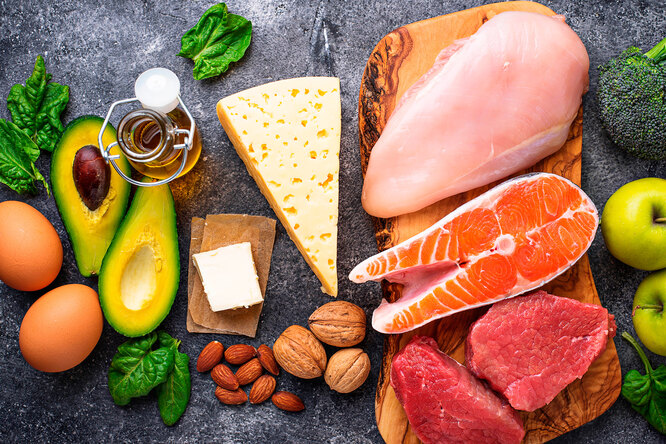Low-fat diets
Supporters of low-fat diets claim that the body adapts to them easily, without shaking it up, which guarantees stable results. Another advantage of this group of diets is that changes in eating habits are minimal. Read more: High-carbohydrate diet
Low-fat diets increase the risk of death, while a high intake of saturated fat is associated with a significant – 35% – reduction in the risk of stroke. The results of a large cohort study, PURE (Prospective Urban Rural Epidemiology) involving 135,335 people aged 35-70 years from 18 countries, both poor and rich, with a mean follow-up time of 7.4 years, have been published in The Lancet[1].
The classic low-fat diet
The aim of the diet is to reduce consumption of fatty foods, and preferably replace it with low-fat foods, so that the amount of fat in the diet does not exceed 40 g. There are few really fatty foods: butter, vegetable margarine, mayonnaise, cheese, pork sausage, sausages, wieners, fatty meat, gourmet fish (salmon, trout), cakes with cream, ice cream. Replace fatty meat with lean meat, salmon with cod, cheese with cheese-cheese or brynza, cake with marmalade, jam, marshmallow etc.
Only choose meat that is boiled, baked or grilled, wholemeal bread and low-fat dairy products. Under a ban for the time of the diet would be beans, nuts, chocolate, cocoa, sugar, jams, jam and alcohol. If you follow this ban, you should not count the calories of the rest of the foodstuffs.
Vegetables, mushrooms and fruit will form the basis of your menu. Following a low-fat diet reduces the risk of cardiovascular, liver and kidney diseases. A low-fat diet is, however, a way of losing weight, and not an option for a healthy diet. Long-term exclusion of fatty foods can cause vitamin A, D, K and E deficiency, which leads to physical and mental fatigue, to menstrual cycle disorders in women, dry skin and hair loss.
The first variant of the low-fat diet
- First breakfast: 2 soft-boiled eggs, 1/2 grapefruit, 1 orange, 1 apple, 200 ml of prune compote, 25 g of wholemeal bread with light butter.
- Second breakfast: 100 g of fruit salad with sultanas and nuts; 400 ml of fruit juice.
- Lunch: 25 g of wholemeal bread with light butter; 100 g of tomato salad with greens; 100 g of fruit salad; 200 ml of juice.
- Dinner: 150 ml of vegetable soup, 90 g of lean meat or fish, 3 egg omelette with potatoes, 150 g of green salad. Alternatively, eat 100 g of pasta, 60 g of pudding with semolina, 150 g of vegetable salad and 200 ml of compote.
Second low-fat diet option
- First breakfast: 20 g of breakfast cereal; 250 ml of skimmed milk; 1 banana.
- Second breakfast: 2 jacket potatoes; 100 g of green salad.
- Lunch: 200 ml onion soup with potatoes; 100 g chicken with brown rice and curry sauce; 40 g marshmallow; 200 ml non-fat yoghurt or 100 g non-fat cottage cheese.
- Dinner: 2 cheese cakes made from skimmed cottage cheese; 200 ml
skimmed kefir.
The weight is lost slowly (1-4 kg per month), but surely.
Low-fat diet by Michael Ginzburg
The ‘low-fat’ or ‘impulse’ diet of Michael Ginzburg also refers to low-fat diets. It, too, no bans on products, but limits the consumption of fatty foods by replacing them with low-fat or fat-free. To avoid vitamin deficiencies, Ginzburg recommends introducing more fish into your diet. The idea of the pulse diet is that, in addition to eating a low-fat diet, you should do two days off per week. Ginzburg recommends eating 500-600 g of fresh or boiled vegetables and 300-400 g of fruit on day 6. The amount of liquid is not restricted, its choice is limited: it may be mineral water without gas or green tea without sugar. The standard set of products for the diet: low-fat, low-calorie, sugar-free and fibre-rich foods.
The time of the last meal is not regulated.
Misconceptions about low-fat vegan diets
Unscientific thinking is inherent in the vegan community and is perpetuated by some well known in this narrow circle of authors as well as respected authorities. Unfortunately, most authorities have their biases.
This irresponsible approach within the vegan community is detrimental to the health of people following the recommendations of its representatives. In fact, veganism proponents, while adhering to a strict, devoid of correction by the latest scientific findings diet, suffer from the similar approach of veganism representatives.
Those with unique digestive and absorptive needs need a slight modification of dietary standards.
More often than not a small percentage of people have an increased need for fats and proteins, as is the case, for example, with adolescents in children, professional athletes, pregnant and lactating women. Genetic differences in fatty acid metabolism should also be taken into account.
Research
For example, about thirty years ago, some enthusiasts of a healthy vegan diet suggested that the benefits of such a diet came from the fact that it was low in fat. The extremely low-fat vegan diet quickly gained significant media support once its ability to prevent heart disease was clinically demonstrated. After that, fat became the dietary villain of our time. The more fat you can eliminate, the leaders of this community argued, the better. This view seemed reasonable at the time, largely because scientific studies of fat consumption (which showed negative health effects) examined the effects of fats from refined vegetable oils and animal products. Thus, it is not unreasonable to assume that the main benefit of a vegan diet is the avoidance of fats. After all, almost all vegans follow a low-fat vegan diet, ignoring vegetable oils and almost all seeds and nuts, trying to ensure that their caloric intake through fat does not exceed 10%.
This means that for the majority of participants this style of diet is the solution to heart disease.

